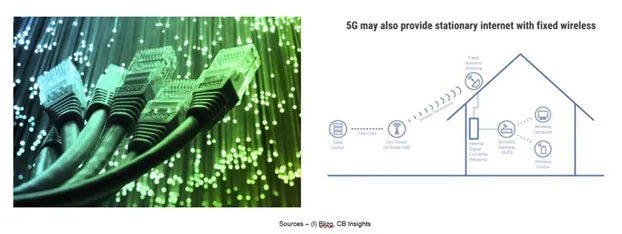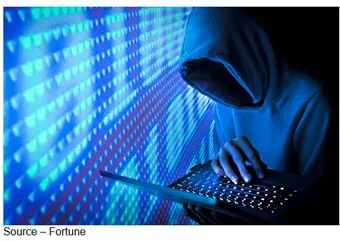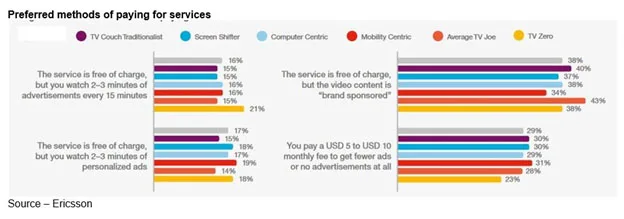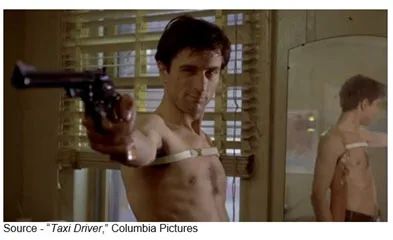We Pay for Entertainment One Way or Another, But it’s Nice to Have a Little Help

We totally wasted most of last weekend!
Saturday afternoon we binged four segments of Rod Serling’s Twilight Zone – in a row – over our slim cable system bundle. Bright and early, we jumped on CBS All Access and watched three episodes of Jordan Peele’s new Twilight Zone.
One group of shows we watched at the prescribed times and in the order they offered them. The other? We started with number one, then two and…
Folks have asked why we continue with our old-fashioned Pay-Tv when we can get everything we really want and all the newest stuff OTT.
People like to slide right past the big hurdle for viewing content … getting the stuff from there to here.
Reason 1
We have to get the content to the screen and the choice is either with cable or 4G LTE wireless (someday 5G).
Fiber download is supposedly 2Gbps max (usual 1Gbps) download and 5G is theoretically 450Mbps (best case 1Gbps) but 100Mbps will easily stream 4K/HDR content to the screen with sufficient bandwidth to handle 8K whenever it’s available.
Cable fiber is here and 5G is coming and it looks a little more difficult.

Cable is reliable unless someone cuts it with a backhoe or a shark chews through one of the 550,000 miles of undersea cables.
We’re just beginning to build out the global 5G infrastructure and by 2025, it should be as good if not better; but we want to watch our entertainment now.
Reason 2
Okay, we don’t like our cable guy very much (who does); but we like him a little better than the phone guy.
The day/time TV people have gotten the message as people cut, shave or don’t even bother with their expensive bundle “service” and less than stellar customer service.

And in many instances, they have responded with:
- More flexible service/channel option programs
- Online service, support
- Added features, capabilities like voice command and catch up on shows you missed
- Improved service/support programs
- Adding subscription services to their offerings
Sure, there is always room for improvement; but sometimes, it’s the devil you know
Then there’s the deafening noise from the wireless industry.
The telephone guy just can’t seem help himself from making outlandish claims for what is really going to be a widely available, super service.
AT&T said they were delivering 5G the first of the year and offered a 5G E phone … the E stood for eventually because it was running on very good 4G LTE service, but really?
China, South Korea and U.S.’s telcos rush to announce the success of their first trials and the breathtaking performance, which is loosely translated as ultra-high speed, downhill, with a strong wind at its back.
We get it.
Bragging rights are important but more important is delivering high-speed, reliable, economic service to folks around the country who are outta’ touch.
As for being economic:
- South Koreans could have an 8GB data plan for $50 a month (4K mobile stream is 7.2GB/hr.), no unlimited plans
- With AT&T, after buying a 5G mobile hotspot for $500 you can consume up to 15GB of content for $70/mo. in a few cities
- Verizon … comparable
- Europe – 35 5G cities identified in 14 countries to receive 5G coverage by 2020 with tens of base stations and thousands of small cells

There are vast portions of the country – every country – where minimal (sometimes zero) service is available which is why Amazon, SpaceX, OneWeb, Boeing, Spire Global, VSAT, Tata and others are investing to deliver connectivity to communities overlooked.
Stringing cable to these isolated locals is ridiculously cost prohibitive but beaming service is economical and darned important!
They may have no interest – or need – in watching Twilight Zone but Discovery, History, Nat Geo, BBC, Encuentro, France 5, KTN Leo, IRIB Mostanad, Rai Scuola and hundreds/thousands of channels around the globe help everyone.
Good Content Costs
The great thing about the U.S. and most industrial countries around the globe is that suddenly we have an insane amount of really good content to choose from and you pay for it one way or another.
Of course, you can get it free:
- Some people mooch Netflix passwords from their friends who, for some reason, don’t mind spreading the love.
- Others patronize pirate movie/TV sites where they can get content free with more free stuff … malware.
Cool!
Yes, the biggest problem in our increasingly content-rich world is that:
- We switched from analog to digital
- We switched from shipping content over cable broadband to OTT streaming

Streaming service data breaches (hacks) ranged in size from 133 to 200 million – 11.6B from May – Dec last year, according to Akamai.
That costs services – Netflix, HBO, Hulu, Disney, Sky, Amazon, Mubi, Shudder, fubo, Philo, heck, everyone – Billions every year.
And there’s a trickle-down effect. It takes money directly/indirectly from the thousands of really hard-working Indie filmmakers and crew members!
Not nice!
But like most sane folks, we respect the creative work these people do and feel they should be fairly compensated and have options … lots of options.

Advertising icon David Ogilvy once said, “The two most powerful words you can use in a headline are FREE and NEW. You can seldom use FREE, but you can almost always use NEW – if you try hard enough.”
Ever since Netflix dropped their red envelopes and focused on streaming content to people’s devices, they and their leading competitors (HBO, Hulu, Amazon) and their growing field of competition – CBS All Access, Disney +, sometime soon Apple TV + and others have focused on pitching new content.
For those without huge libraries of content, such as Netflix, it has led to major content development investment ranging from $1B annually to $19B annually.
To attract new subscribers, they have used a very aggressive marketing program of social media activity, outdoor advertising, aggressive promotion of films/projects at film festivals and industry awards programs – Grammys, Oscars, etc.

Multiply that by word of mouth and friends telling friends and it has worked … beautifully.
Streaming analysts love to say traditional Pay-Tv (stuff delivered over the cable or satellite) is dying as people shift to the great new anytime, anywhere streaming services. The only problem is people are still paying for the wired or wireless service the same old way–a fixed monthly fee (for each) plus the service provide fee.
People extol the benefits of streaming because they can watch the stuff on their smartphone during business meetings, classes–heck, everywhere. The problem is the majority of the entertainment is still consumed sitting on the couch and staring at that big, beautiful screen you bought and like to brag about.
And according to Liechtman Research Group, while there was an initial thrill and rush to computer-, tablet- and smartphone-viewing; the “newness” has worn off and BAM! they’re back to the big screen.

So, the big difference is that instead of the big bundle of 300 channels, of which we watch maybe ten over the course of a year, we have a slim bundle of ten channels plus three OTT services that we use to watch one to two shows a week.
And the cost? Yep, darn near where we were before plus there are two to three other services we’re sorta’, kinda’ interested in.
So much for saving scads of money and having the added convenience of watching everywhere/anywhere.
Yes, there is the convenience of anytime viewing.
You can call us inflexible, but we’re interested in watching the 7:00 p.m. news at … 7:00 p.m.
Research Intelligencer found that families dismantled their “store bought” bundle to develop their own personal bundle that met the family’s wants and needs. That’s probably why instead of the annual spend for home entertainment, it actually hit a record of $23.3B last year, up 11.5 percent.
While many of the folks GfK interviewed said they had cut or severely shaved their Pay-Tv cable explained they did it to escape advertising but upon further discussion it wasn’t getting rid of ads but the volume of the ads.
As David Ogilvy emphasized, free is one of the most powerful words in a headline; and to enjoy free entertainment, someone had to underwrite the cost … advertisers.
GfK found that people who switched to streaming services were simply sick and tired (our words) of too many ads!
More than 4 in 10 respondents(44 percent) say that the lack of ads is the top reason for using paid streaming services, and three-quarters feel there are too many ads on Pay-Tv.
Obviously, ads haven’t deterred younger viewers from rushing to Google’s YouTube.
Because of possibility of ads showing up on or around offensive content, most advertisers view the option with mixed feelings because one wrong appearance can (and has) caused irreparable damage to the product and company.
Television network and program owners heard the door slamming and responded by taking a hard look at their TV ad bundles.
They trimmed the total time of commercials shown with Fox saying they were reducing add time to two minutes an hour by next year.
At the same time, advertisers have begun experimenting with shorter ads (6,10,15, 30 sec) and a broader range of variety of ads (mix rather than repeat).

While Magna noted in its recent global report that ad revenues in linear TV has contracted 3.6 percent this year, OTT advertising actually expanded by 54 percent last year and is projected to increase another 39 percent this year, well ahead of social and digital video.
As a result, Magna noted that a number of SVOD players – Netflix, Amazon, Hulu and others are exploring hybrid, add-supported business models with offerings with limited ads or company/product sponsored.
Vincent Letang, Magna executive vice president-global market intelligence, said that the long-term trend will continue; and initially, AVOD services will have a decided advantage because they will be able to deliver specific ads to individual viewers rather than have to sell broad demographics.
Ad-supported entertainment will change significantly over the coming years; and as it becomes more personalized, it will become more accepted and appreciated.
 Advertising will become more seamlessly brought into the entertainment scene and will ultimately be more effective.
Advertising will become more seamlessly brought into the entertainment scene and will ultimately be more effective.
At some point, we’ll have a eureka moment just as Travis Bickle did when he said, “Now I see it clearly. My whole life is pointed in one direction. I see that now. There never has been any choice for me.”
# # #